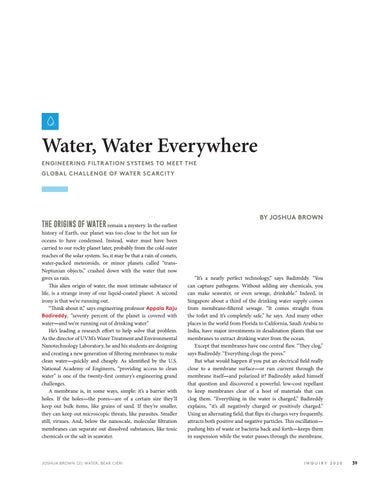Water, Water Everywhere ENGINEERING FILTR ATION SYSTEMS TO MEET THE GLOBAL CHALLENGE OF WATER SCARCIT Y
THE ORIGINS OF WATER remain a mystery. In the earliest history of Earth, our planet was too close to the hot sun for oceans to have condensed. Instead, water must have been carried to our rocky planet later, probably from the cold outer reaches of the solar system. So, it may be that a rain of comets, water-packed meteoroids, or minor planets called “transNeptunian objects,” crashed down with the water that now gives us rain. This alien origin of water, the most intimate substance of life, is a strange irony of our liquid-coated planet. A second irony is that we’re running out. “Think about it,” says engineering professor Appala Raju Badireddy, “seventy percent of the planet is covered with water—and we’re running out of drinking water.” He’s leading a research effort to help solve that problem. As the director of UVM’s Water Treatment and Environmental Nanotechnology Laboratory, he and his students are designing and creating a new generation of filtering membranes to make clean water—quickly and cheaply. As identified by the U.S. National Academy of Engineers, “providing access to clean water” is one of the twenty-first century’s engineering grand challenges. A membrane is, in some ways, simple: it’s a barrier with holes. If the holes—the pores—are of a certain size they’ll keep out bulk items, like grains of sand. If they’re smaller, they can keep out microscopic threats, like parasites. Smaller still, viruses. And, below the nanoscale, molecular filtration membranes can separate out dissolved substances, like toxic chemicals or the salt in seawater.
JOSHUA BROWN (2); WATER, BEAR CIERI
BY JOSHUA BROWN
“It’s a nearly perfect technology,” says Badireddy. “You can capture pathogens. Without adding any chemicals, you can make seawater, or even sewage, drinkable.” Indeed, in Singapore about a third of the drinking water supply comes from membrane-filtered sewage. “It comes straight from the toilet and it’s completely safe,” he says. And many other places in the world from Florida to California, Saudi Arabia to India, have major investments in desalination plants that use membranes to extract drinking water from the ocean. Except that membranes have one central flaw. “They clog,” says Badireddy. “Everything clogs the pores.” But what would happen if you put an electrical field really close to a membrane surface—or run current through the membrane itself—and polarized it? Badireddy asked himself that question and discovered a powerful, low-cost repellant to keep membranes clear of a host of materials that can clog them. “Everything in the water is charged,” Badireddy explains, “it’s all negatively charged or positively charged.” Using an alternating field, that flips its charges very frequently, attracts both positive and negative particles. This oscillation— pushing bits of waste or bacteria back and forth—keeps them in suspension while the water passes through the membrane.
I N Q U I RY 2 0 2 0
39







